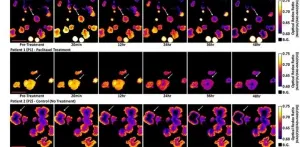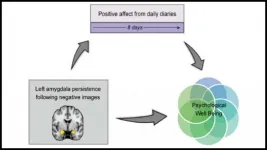(Press-News.org) The pandemic has exposed weaknesses in nursing homes, causing many families to rethink whether to keep an aging parent at home instead. Now a new study by UC San Francisco has found that many elderly Americans lack the basic self-care equipment that could enable them to live at home longer, postponing the need to move into residential care facilities.
In the study, researchers focused on three inexpensive, low-tech assistive devices: grab bars around the toilet and in the shower or tub area; a shower or tub seat; and a raised toilet or toilet seat. They identified approximately 2,600 seniors who were representative of Medicare recipients nationwide and were drawn from the National Health and Aging Trends study. These seniors lived at home but had mobility constraints, defined as substantial difficulty with bathing and toileting, keeping balanced and transferring from a seating to standing position.
The study found that 42 percent were found to have an "unmet need," if they lacked both bathroom devices and/or both toilet devices. When transposed to the national population, this cohort amounted to 5 million Americans, representing "a missed opportunity to help [them] live independently and safely," the researchers reported. The study publishes in JAMA Internal Medicine on March 22, 2021.
"In contrast with engineered T-cells and regenerative stem cell therapy, this equipment seems mundane," said first author Kenneth Lam, MD, of the UCSF Division of Geriatrics, noting that each device costs around $50 and is not covered by Medicare. "Yet these low-tech interventions meaningfully reduce injury, enable independence, preserve dignity and improve quality of life in older people suffering from irreversible disability for complex multifactorial reasons."
Culturally, we are drawn to the idea of reversing aging rather than adapting to it, Lam said. "We'd rather read a book that says we'll never age than a book on how to cope with it. Yet many of us will get old and I believe, paradoxically, a fixed mindset that does not tolerate the adaptations that have to come with an aging body can make the experience of aging much worse."
In Acquiring Home Devices, Self-Image May Trump Need in Younger Seniors
Younger age was found to be associated with not having the equipment participants needed: Among those ages 65 to 74, half had an unmet need, versus 29 percent for those who were 85 or older. Of note, participants who already had a walker were more likely to be better equipped.
"Many people find equipment stigmatizing," said Lam. "Aesthetics are unappealing, and some may fear being perceived as old and vulnerable; older adults describe equipment as meant for 'someone older,' but not for themselves. This may explain why younger individuals were more likely to have unmet needs and why those who already owned a walker were the least likely, since they had already overcome stigma around assisted device use."
The researchers also found that nonwhites were more likely to lack equipment - 38 percent of whites had an unmet need, compared with 55 percent of other races - a finding that the authors say could be due to disparities in access or attributable to minority populations providing more caregiving in lieu of equipment.
The paucity of devices could also be explained by physicians' failure to ask about patients' home environments and recommend appropriate devices, Lam said. Many ER admissions of the elderly arise out of domestic incidents, such as tripping on the way to the bathroom, but asking about assistive devices "simply isn't part of our training."
Other Aids May Make Home Safer for Seniors with Memory Issues
Some 35 percent of the participants had probable or possible dementia. There are multiple home adaptations that could make it easier for this demographic, Lam stated, though he cautions that their usefulness has not been well studied. These include pill boxes that remind and assess whether medications were taken, electronic locks to monitor movement in and out of the home, and safety stoves that turn off if left unattended. Music, activity blankets and dolls may also soothe restless behaviors.
While these home modifications are inadequate to keep all seniors at home, Lam believes they may make caregiver burden more tolerable and delay the transition to nursing homes for some people.
INFORMATION:
Co-Authors: Senior author is Kenneth Covinsky, MD, MPH, of the UCSF Division of Geriatrics. Co-authors are Ying Shi, PhD, also of the UCSF Division of Geriatrics and John Boscardin, PhD, of the UCSF Division of Epidemiology and Biostatistics.
About UCSF: The University of California, San Francisco (UCSF) is exclusively focused on the health sciences and is dedicated to promoting health worldwide through advanced biomedical research, graduate-level education in the life sciences and health professions, and excellence in patient care. UCSF Health, which serves as UCSF's primary academic medical center, includes top-ranked specialty hospitals and other clinical programs, and has affiliations throughout the Bay Area. Learn more at https://www.ucsf.edu, or see our Fact Sheet.
Follow UCSF
ucsf.edu | Facebook.com/ucsf | YouTube.com/ucsf
Social deficits attract so much attention in the study of autism spectrum disorder, it's easy to forget there are motor learning deficits during early childhood as well. For autistic kids hoping to throw a ball around the schoolyard and connect with classmates, these physical skill differences can isolate a child further.
In a new study published in Nature Neuroscience, researchers from the University of Ottawa's Faculty of Medicine have closed in on the neurological underpinnings of the motor learning delay.
Dr. Simon Chen's lab in the Department of Cellular and Molecular Medicine of the Faculty of Medicine used a mouse model of autism to demonstrate a shortage ...
Though 40 million concussions are recorded annually, no effective treatment exists for them or for many other brain-related illnesses. In collaboration with Dragan Maric of the National Institutes of Health, Badri Roysam, Hugh Roy and Lillie Cranz Cullen University Professor and Chair of Electrical and Computer Engineering, and his team are working to speed up drug development to treat brain diseases and injuries like concussion by developing new tools.
"We are interested in mapping and profiling unhealthy and drug-treated brain tissue in unprecedented detail to reveal multiple biological processes at once - in context," said Roysam about his latest paper published ...
NEW YORK, NY (March 22, 2021)--The first year of the COVID-19 pandemic has taken the lives of millions of people around the world but has also left hundreds with lingering symptoms or completely new symptoms weeks after recovery.
Much is unknown about what causes these symptoms and how long they last. But with nearly 740,000 cases of COVID reported in New York City since last March--and 28 million in the United States--physicians are increasingly seeing these "long-haulers" in their practices.
"Over the course of the summer, we started getting a sense of what issues these people were having," ...
Organoids are tiny three-dimensional cellular assemblies that are grown in a laboratory from tissue-specific cells. They are particularly interesting to biologists because of their ability to mimic the characteristics of the original tissues. If scientists extract cells from a tumor, then they can grow cancer organoids that mimic the characteristics of the source tumor.
This possibility for individual-level studies of tumor properties makes cancer organoids an exciting tool from the perspective of an emerging field called precision cancer medicine. Daniel Gil of the University of Wisconsin ...
CLEVELAND--A new technique for sampling and testing cells from Barrett's esophagus (BE) patients could result in earlier and easier identification of patients whose disease has progressed toward cancer or whose disease is at high risk of progressing toward cancer, according to a collaborative study by investigators at Case Western Reserve University and Johns Hopkins Kimmel Cancer Center (JHKCC).
Published in the journal Gastroenterology, the findings show the combination of esophageal "brushing" with a massively parallel sequencing method can provide an accurate assessment of the ...
For something we spend one-third of our lives doing, we still understand remarkably little about how sleep works -- for example, why can some people sleep deeply through any disturbance, while others regularly toss and turn for hours each night? And why do we all seem to need a different amount of sleep to feel rested?
For decades, scientists have looked to the behavior of the brain's neurons to understand the nature of slumber. Now, though, researchers at UC San Francisco have confirmed that a different type of brain cell that has received far less study -- astrocytes, named for their star-like shape -- can influence how long and how deeply animals sleep. The findings could open new avenues for exploring sleep disorder therapies and help scientists better understand brain diseases linked ...
A large study of brain MRI scans from 11,679 nine- and ten-year-old children reviewed by UC San Francisco neuroradiologists identified potentially life-threatening conditions in 1 in 500 children, and more minor but possibly clinically significant brain abnormalities in 1 out of 25 children.
The results provide the best estimates to date of the true incidence of various structural abnormalities in the developing brain, and raise the question of whether all MRI brain imaging obtained during research studies should be reviewed by board-certified radiologists, as was done in this study, in the hopes of saving lives and alerting participants to incidental findings that ought to be medically evaluated.
One ...
How the amygdala responds to viewing negative and subsequent neutral stimuli may impact our daily mood, according to new research published in JNeurosci.
The amygdala evaluates the environment to find potential threats. If a threat does appear, the amygdala can stay active and respond to new stimuli like they are threatening too. This is helpful when you are in a dangerous situation, but less so when spilling your coffee in the morning keeps you on edge for the rest of the day.
In a recent study, Puccetti et al. examined data collected from the "Midlife ...
MINNEAPOLIS/ST.PAUL (03/22/2021) -- New research from the University of Minnesota Medical School suggests that disease-driving B cells, a white blood cell, play a role in the development of non-alcoholic fatty liver disease (NAFLD) - the most common chronic liver condition in the U.S. Their findings could lead to targeted therapies for NAFLD, which currently affects a quarter of the nation and has no FDA-approved treatments.
After noticing that patients with the disease showed a large number of inflammatory B cells in their livers, Xavier Revelo, PhD, an assistant professor in the Department of Integrative Biology and Physiology and senior author, began studying B cells in NAFLD.
"This disease is increasing in prevalence ...
Although Tuberculosis, or TB, killed nearly as many people as COVID-19 (approx. 1.8 million) in 2020, it did not receive as much media and public attention. The pandemic has proven that transmissible infection is indeed a global issue. TB remains a serious public health concern in Ireland, particularly with the presence of multi-drug resistant types and the numbers of complex cases here continuing to rise, with cases numbering over 300 annually.
Science tells us that iron is crucial for daily human function, but it is also an essential element for the survival of ...



